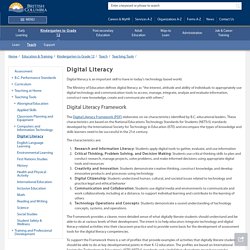

Digital Passport™ by Common Sense Education. Ed. Guide Digital Passport (CommonSense) 10 Fun Digital Citizenship Videos for K–5 Classrooms. Get students thinking and talking about how to be safe and responsible digital citizens.

From an early age, it’s important for students to start learning healthy media habits. More and more, digital citizenship skills like balancing screen time with other activities, being kind to others online, and knowing what’s OK and not OK to share online are essential at the elementary school level. But working digital citizenship lessons into an already-packed daily schedule can be a challenge for most teachers.
For Digital Citizenship Week 2019, we’ve put together a series of quick video discussion activities you can use to kickstart your commitment to digital citizenship. These can fit into a short, 10-minute window of time -- be it planned or unplanned. Activities for Grades K–2 Media Balance Is Important. Digital Citizenship Week. How Tech Is Changing Childhood. Global Explorers [Workshop] Workshop Description: How do we get our news?
![Global Explorers [Workshop]](http://cdn.pearltrees.com/s/pic/th/global-explorers-workshop-183255576)
What stories do we see and which do we miss? How do we build a balanced news diet that includes reliable sources covering the world’s pressing, under-reported global stories? Students explore these questions in this 90 minute workshop that illuminates students’ interest in global news while also identifying methods for expanding their access to it. Through text, photo, and video exploration and interactive exercises, students will analyze how global issues connect to their local communities and identify practical ways to bring more diverse news outlets and topics into their news routine. Warm-up: 1. Hands up if you get some of your news from: A print source (newspapers, magazines)TVOnline newspapers, magazines, blogsSocial mediaWhat publications do you look at under each category?
2. NewsNews outletUnder-reported story Photo/Video Exploration—Going Beyond the Clickbait: What can we learn from a photo? This is a picture from a news story. 1. 2. Being a Better Online Reader. Soon after Maryanne Wolf published “Proust and the Squid,” a history of the science and the development of the reading brain from antiquity to the twenty-first century, she began to receive letters from readers.

Hundreds of them. While the backgrounds of the writers varied, a theme began to emerge: the more reading moved online, the less students seemed to understand. There were the architects who wrote to her about students who relied so heavily on ready digital information that they were unprepared to address basic problems onsite. There were the neurosurgeons who worried about the “cut-and-paste chart mentality” that their students exhibited, missing crucial details because they failed to delve deeply enough into any one case. And there were, of course, the English teachers who lamented that no one wanted to read Henry James anymore. Certainly, as we turn to online reading, the physiology of the reading process itself shifts; we don’t read the same way online as we do on paper. KidRex - Kid Safe Search Engine. A Google a Day. Becoming a Google Searching Guru - Google Slides.
Boolean operators, wildcards and special characters. Changing the Conversation About Librarians. Being a Better Online Reader. Digital & Media Literacy. Digital Literacy - Province of British Columbia. Digital literacy is an important skill to have in today's technology based world.

The Ministry of Education defines digital literacy as “the interest, attitude and ability of individuals to appropriately use digital technology and communication tools to access, manage, integrate, analyze and evaluate information, construct new knowledge, create and communicate with others”. The Digital Literacy Framework (PDF) elaborates on six characteristics identified by B.C. educational leaders. These characteristics are based on the National Educations Technology Standards for Students (NETS•S) standards developed by the International Society for Technology in Education (ISTE) and encompass the types of knowledge and skills learners need to be successful in the 21st century.
The characteristics are: The Framework provides a clearer, more detailed sense of what digitally literate students should understand and be able to do at various levels of their development. 15 Awesome Websites That Tell a Story As You Scroll. This post showcases 15 sites that take parallax scrolling to the next level by combining CSS animations and JavaScript to manipulate page elements upon scroll to immerse the user into a developing story. As new CSS properties are becoming widely supported, designers are combining tools to create amazing websites that were once only feasible in Flash.
Check out these outstanding designs and start scrolling to unveil their full design. These will definitely get your attention, determining you to want to know more about them. Moreover, the parallax scrolling effect, the illustrations or the high-quality images will challenge your imagination. Prepare yourself to be amazed! The Boat Did you think you use your water supply wisely? Here’s a beautiful site to show an alternative mean of transportation, which is also eco-friendly! Having a lot of crazy thoughts? Yes, is all about the movie!
Why use databases? (Infographic)